The History of Art
GA 292
XIII. The Changes in the Conception of Christ During a Certain Period of Time
29 October 1917, Dornach
Today I want to bring you something about the transformations around the concept of the Christ from various viewpoints but set in a specific period of time. In a certain sense one can speak about the influence of the Mystery of Golgotha in every cultural sphere and in order to elucidate the correct idea of its influence on the earth's evolution it is necessary, where possible, to examine this impact independently from each cultural area.
Within the evolution of art, it is possible to speak about the important changes brought about as a result of the impact of the Mystery of Golgotha in the general progress of humanity. However, these thoughts will not suffice without the awareness which link to, I might call it, intimate artistic changes in the evolution of individual arts.
When we start looking for the starting point of when people in Europe depicted the Christ figure, it is repeatedly shown that the attempt to depict the Christ figure artistically actually only started from the moment when, within historical development, the concept of the Gospels as a literal perception of Christianity experienced a conclusion to a certain extent, a view of the Mass and Gospel traditions through participation in the church thus rejecting some declarations considered questionable at the time. When the foundation of Gospel literature was completed and also the transition was made to a certain degree in the minds of those looking at the content of the Gospels, a desire started in the West to artistically depict scenes and figures found in the Gospels.
This should not be lost sight of. Before the Gospels were concluded and rounded off in the minds of those calling themselves Christians, they limited their imagination to a depiction as a signature which you can see in this slide of the monogram of Christ:
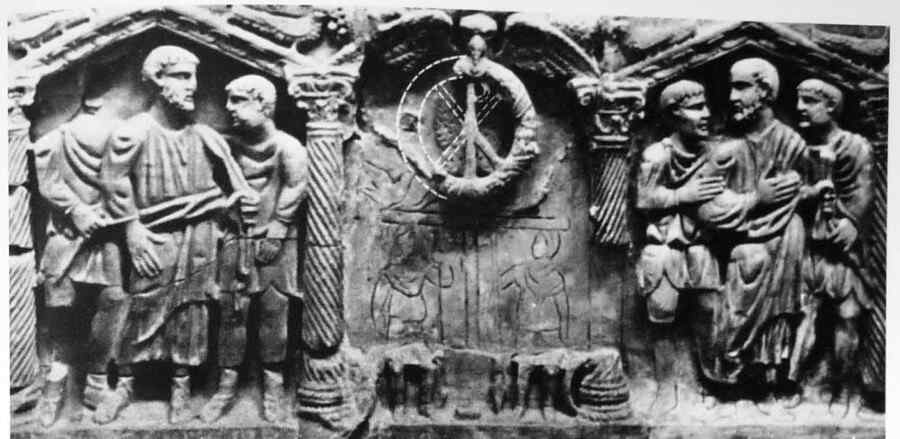
710 Christ monogram
See in the centre the Χ and the Ρ, ie. Chi and Rho, which is simultaneously the angled Cross with the Rho.
Or you see it in a similar form, as you see here:
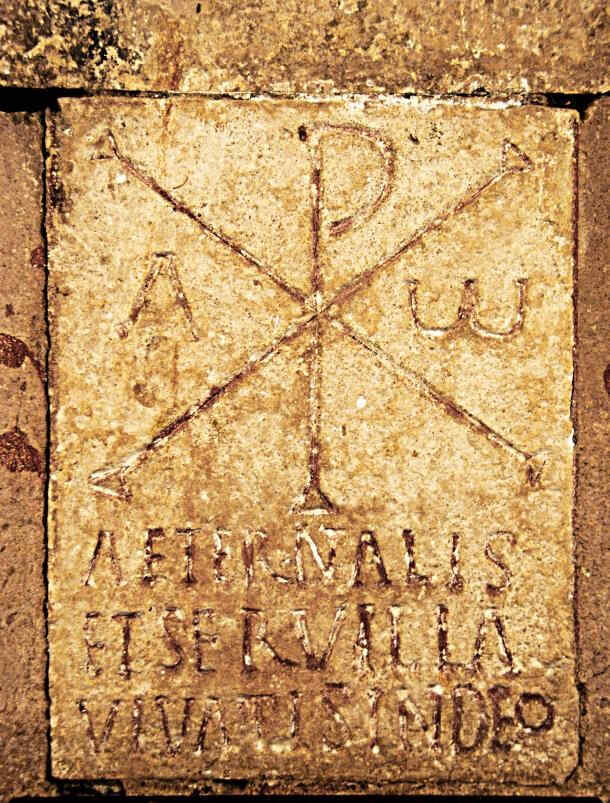
712 Christ monogram
... or combined with animal figures:
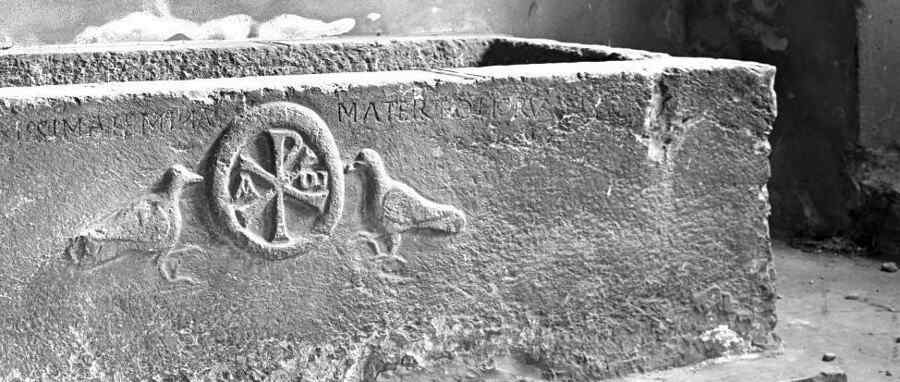
713 Christ monogram with two doves.
... or the changed form, as we have here:
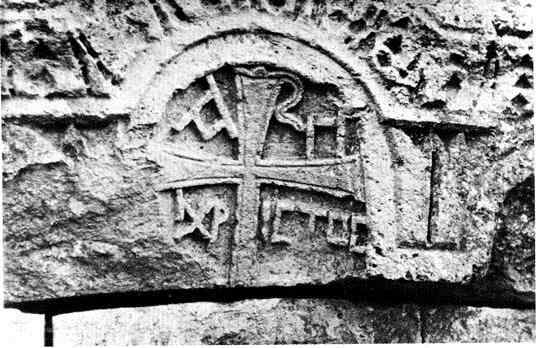
711 Christ monogram:
This is what people limited themselves to during that time, during which the mass of the Gospels became unified and gradually penetrated people's minds. This is the reason why actual pictorial representation of the holy history can only be spoken of as originating from the 2nd or 3rd centuries onwards.
In the course of our local art observations which I have emphasized I want to point out another relationship today by referring to what I've highlighted before. I have stressed that the first representations which were created still obeyed the forms of the old, ancient pagan artistic development.
People simply transposed the pagan artistic expression on to the content of the Christian development. This is very important. One can say that before and up to the 3rd Century nothing had been done in the western cultural development to depict images of the Gospel scenes as such, which had not come as a transfer from pagan art. Here we find figures which we connect to Christian representation as similarly depicted to what we usually see in pagan myths. Today we want to limit our observations to the Christ figure Himself. In this regard we find at the start of the first times the Christ is represented, most frequently of all, the image of the Good Shepherd, in the most varied forms in antiquity, presented in the pre-Christian times. This image—chosen from one out of many representations of “The Good Shepherd”:
714 Mosaic of the Good Shepherd, Mausoleum of Galla Placidia, Ravenna ...
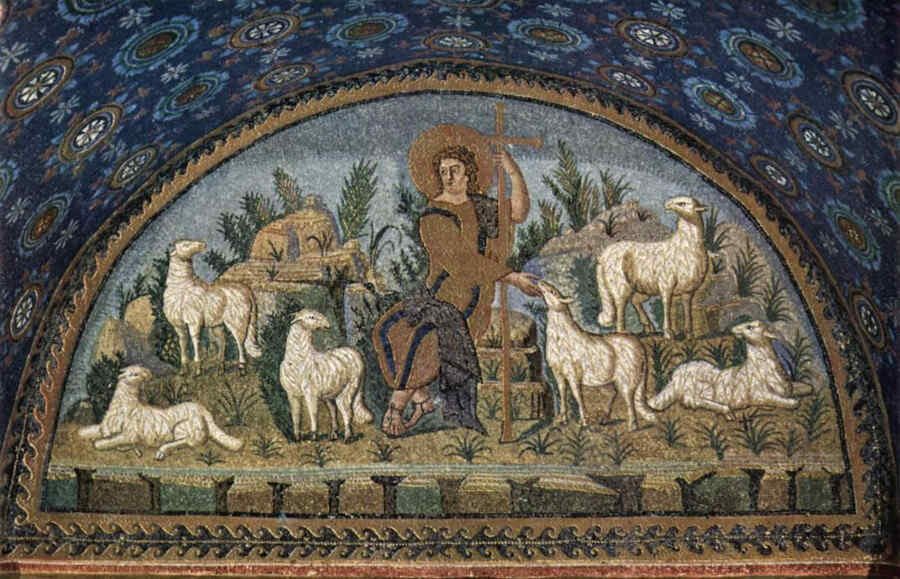
... reminds us of the depiction of David amongst the animals. It reminds us of other Greek images.
If we limit ourselves in particular to the Christ figure in this image, as it still stands, you see an absolutely antique expression. We notice the endeavour in this pictorial representation towards the expression of a mild, noble face, generally found in these olden times, beardless, still with tousled hair, youthful, gracious. These were the endeavours which live in all these images. We already see in this representation of the Christ imagery the pagan imagery imposed on it as the basis because in such images everything is still pagan. Now a question about such a statement is created: what precisely characterizes the paganism in this imagery—I'm speaking from an artistic point of view. So much has been written and spoken about art but the essential vigour, if I may call it that, of the pagan artistic expression has not been stressed. When you—as much as it is possible from what is still available—study Greek imagery you will very gradually find the fact that this Greek imagery, studied realistically in the sense we speak of realism today, did not exist. The forms of the human body were not presented by the Greeks as a direct likeness of a portrait of some model, corresponding in any way at all as a mere copy of the human body as it walks the earth because the Greek simply had an ideal body in mind. This ideal body they had in mind, actually incorporated something quite different from what human eyes could actually see in a model. In order to really understand the most important Greek bodily depictions, the artistic physical forms, one has to refrain from considering what the eyes see in the model and its form; one should remember what I already mentioned in previous years: the Greek depiction is according to the inner feelings experienced within the body. A muscle wasn't merely a direct rendering according to what the eye saw but how it was being experienced, how with inner feeling it cooperated with movement, streamlined with muscle contraction. The rendering in artistic matter carried a feeling which was being experienced within the physical itself.
What single factor made this possible? Indeed, it was only possible as a result of the Greek artist, when connecting his thoughts to the physical nature of a person in the majority of his creative images, he relinquished the individual nature of the person. He refrained from including it. When he looked, he saw only the physical expressed in the human form. Pay attention—he looked at the physical nature of mankind as if it represented the outcome of the entire cosmos, as a total spiritual depiction of the cosmos. When you look at a Zeus figure, at a Pallas Athena figure, an Apollo, an Aphrodite figure, you find the soul within it. However, these souls which are within these physical forms are not individual human souls but they are souls that live as results of the entire cosmos: world souls in a human physical form. One could say that what the Greeks searched for as souls in this realm they saw as absolutely beyond the idea that the human is a result of the universe, but that through their thinking they considered the forces cooperating in the universe as striving to produce the crowning glory of its creative forces, the crown of its creative power as a product resulting in the human organism. How focussed and concentrated the creative cosmic forces were, to bring the human form into existence! In such Greek human organisms are the forms I have been telling you about, and here we also find the concentrated expression as seen in laws creating the entire culture, and also through which the entire Spiritual All rules: the creativity of the cosmos condensed in the human being.
One could say the Greeks configured the body in this way. Indeed it seems extraordinary but much more correct if one thinks of what I want to say now. One imagines that when people are asleep, the soul, therefore the `I' and the astral body are outside the physical body and that the sleeping body is ensouled by universal spirituality, absorbed by this spirituality which belongs to the cosmos and through the spiritual aspect being driven out of the human body it has the result of enabling the individual spirituality during earth evolution to enter into humanity and thus one acquires the Greek inspired shaping of human form in such figures, as I have indicated to you. Not that the Greek had no understanding of individual spirituality but he saw the individual soul qualities as not yet penetrating the human form; the human form was for him still something universal. So it happens, which is extraordinary enough, that the individual soul aspect, the specific human soul aspect in Greek art only appears when the Greek does not represent forms which in Greek art, in their higher development, are regarded as typical. When the Greek presents an Apollo or a Zeus, Pallas Athena or Hera or Aphrodite then something typical is presented; when these are not presented, when Satyr or Faun is depicted, then what is presented is pertaining to the individual human aspect, applicable to every soul which is present when it is awake and which leaves the body when it is asleep.
You see this is the curious thing in pagan art development in its highest configuration in Greece. Specific human soul qualities had not penetrated the art forms when the ideal-type aspects were adopted. By contrast all that was working in the soul, the emotions and impulses permeating the soul with the preference of the Satyr and Faun figures, one could say these reminded one of animals. When the Greek presented the god Apoll, then in the god Apoll lived a super human, a super individual soul as an artistic figure of Apollo. Swinging over to the humanistic we first find, in the Greek depiction of a Mercury-type, the Hermes-type. We can find many—you can study the Hermes-type - inspired by the Faun- and Satyr-type. One could say it was the conviction of Greek art that the human soul had not come sufficiently far in its development that it had its own powers to express itself in the human form, when this human form wanted to come out in its full glory.
If we now go even further back in Greek art history we encounter the oriental art form, to discover the total universal cosmic coming into expression. Thus Greek art was the final flowering of universal cosmic expression, the representation having been attempted in the physical human form. It is extremely important that this is looked at.
One can now say that as the Christ became the redeemer in relation to the rest of the powers of evolution in humanity, so He also became the redeemer in relation to this view of art. Imagine an elevated mind posing a question such as this: how can one idealize a representation in order to reach an expression in contemporary art, an expression of something spiritual, something human, how can one idealize something which earlier was merely represented by using the mentioned deviation of an ideal type, namely a Faun-type, a Satyr-type and so on? How can the problem be solved in connection with the specific human form, how can something be idealised which in ancient times did not want to be idealised but that the divine humanistic be kept in contrast to the all-too-human aspect? This question was never stated on the physical plane yet it is answered in the further development of art. It is basically also being answered in the history of humanity.
It will always be part of extraordinary interesting facts that one man in Greece, who so deeply descended into the Greek life that he through his own destiny, to a certain extent, he prepared the redeemer destiny—Socrates traditionally didn't represent and ideal type of Hellenism but more something of a Satyr or Faun.
It is as if world history itself wanted to create the specific human out of the subhuman.
715 Greek sculpture, 4BC, Socrates, scale down copy (London, British Museum)
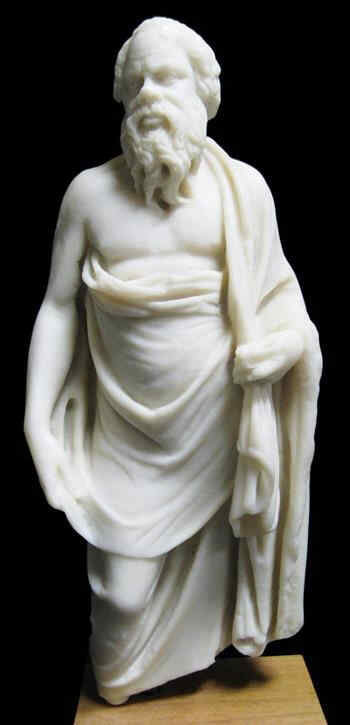
Here we see in the continued progress in the shaping of something which had not been achieved in the ideal humanistic form in Greek counter art, in the Satyr- and Faun art, by wanting to achieve a breakthrough as a human form only originating from the cosmos.
The individually human conforms according to spiritual lines and forms obtained only from the cosmos. Oriental forms we must always look for in the cosmic, but western form in the individually human.
So we see, the moment humanity wanted to conquer the pagan, just then the Christ-type entered in order to penetrate the specifically human into the commonly typically cosmic element. Just observe how that penetrates the typical ...
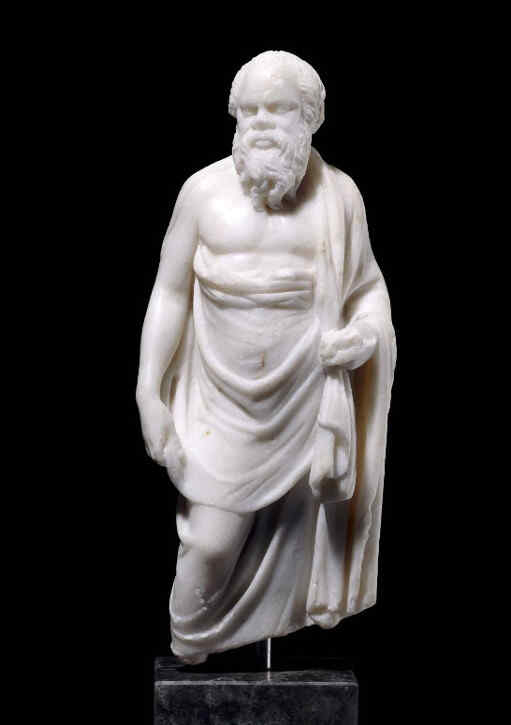
715 Socrates (London, British Museum)
Here we have a
716 Catacomb painting of a Christ depiction (Rome, catacomb of Pontianus)
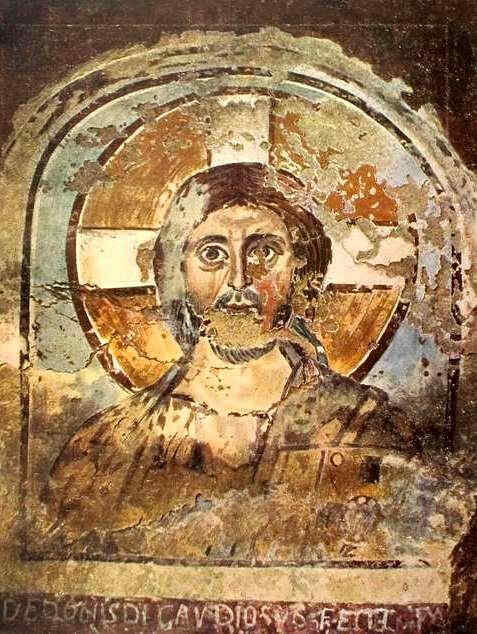
...out of a somewhat later time of ancient Christian art, complete with an added beard, while many Christ representations in the first centuries were beardless. We see how there is a continual attempt to not only make the cosmic aspect in the figure a reality, but to show how the cosmic element is at war with the individuality, how the one is working against the other. The cosmic element here still carries more weight, but actually it outweighs only as tradition. What had to be overcome in the oriental-Hellenistic still carried the most weight, and would still outweigh it for a long time. Only gradually the penetration of the specific enters as the individually human element into the form. So we see how gradually this happens.
I have to show you the next image as a result:
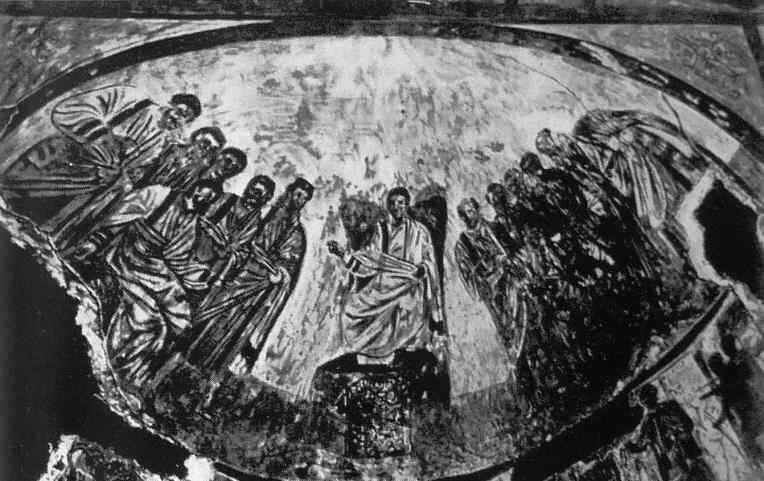
717 Catacomb painting of Christ amidst his apostles.
Here you see—it belongs to the first centuries—how the endeavour existed to maintain the whole arrangement of lines originating from the cosmos, and so on, but as something entering which is specifically human. As a result of this the strange battle started which had particular importance during these ancient centuries, the old battle of how Christ had to be represented; should He correspond more to the Apollo beauty or should He be represented as an individual human soul? The endeavour was to represent Him as an individual man with a soul. Now here is actually the peculiar thing, you see. Here one accomplishes one of those reversals, as we have encountered in other areas during the last days: to represent the human individualism, simply by pulling up again what earlier had been frowned upon. This was developing in the highest degree within Greek trends while in the west, in Latin circles, the continuation was being developed of something which once had been quite oriental—to depict a certain cosmic figure. This was in a time when the unfolding of art in the west dwindled and one could not be sure about the correct explanation any more.
Thus it happened that the depiction of the Christ-form itself triumphed for the eastern, the oriental and Byzantine type of depiction, while the Christ individuality was not included. However, while artistic evolution was on a downwards path one can say that this type degenerated, He no longer retained the lofty dignity which the East wanted to give Him but He was depicted as becoming, one could say, the downward trend of humanity. He became the kind of representation of humanity's characteristics which enter in a degenerative way. His hair was parted, his beard took on particular forms, his expression became such that people saw: the superhuman-cosmic was now being conquered by the human aspect. However people were not yet in the position to really depict this human element as a kind of ideal-type.
We see this exactly when we allow further Christ images to work on us, for example even this very beautiful mosaic in Ravenna:
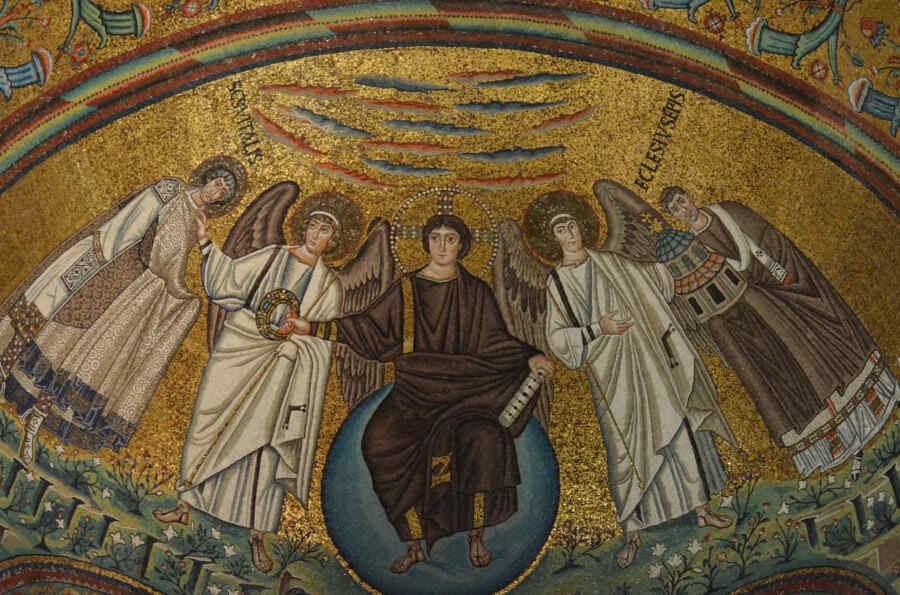
718 Mosaic: “Christ with Archangels crowning the Holy Vitalis” (San Vitale in Ravenna) in which we find neither great beauty, nor a cosmic-universal image, but in which we can already see that an attempt was being made to bring in the human element.
Even more clearly we can be impressed by the expressive images in the mosaic of Palermo—the Monreale Dom, in the apse:
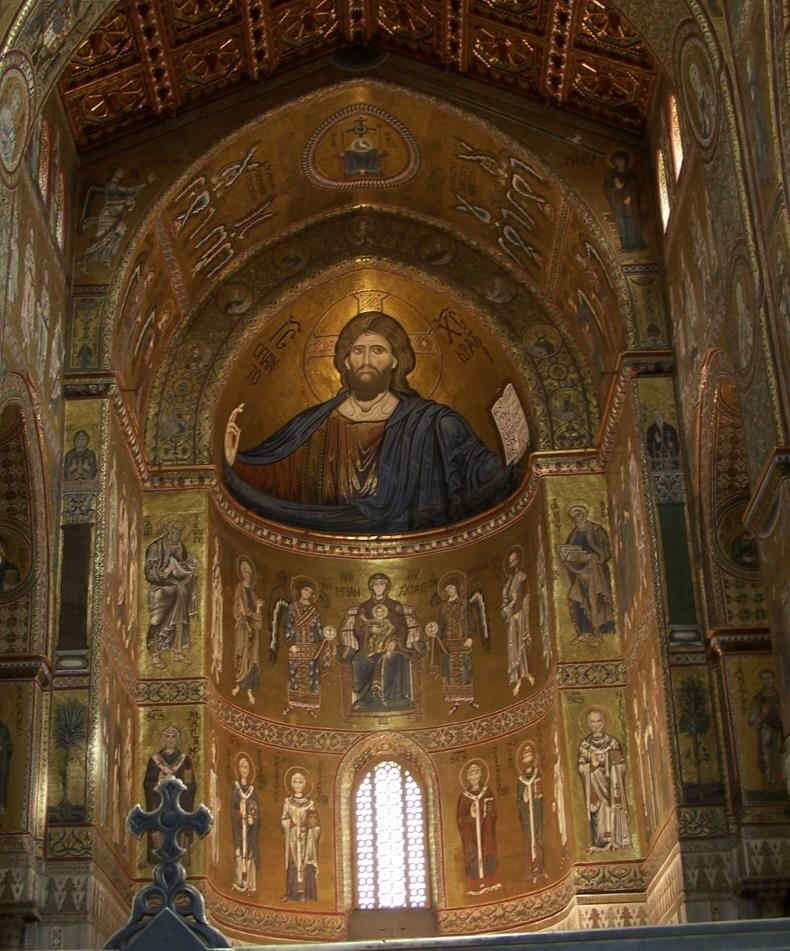
719: Mosaic, 12th Century, Christ, and below Him, Our Lady with the Child.
This is an image which evokes the most immensely impressive thoughts through its wonderful craft of mosaic. However, precisely within these images we see the battle of both streams which we have been speaking about. Exactly as a result of this battle, this image is one of the most interesting regarding what we have ahead.
All of this belongs to the general course of humanity's evolution. We see how in a loop line the individual jumps over the abstract cosmic aspect coming from the East, and lets it go over to the West. I say: the abstracted cosmic element transported over to the West! If you want to understand that then you must above all completely enter into the art of being, into a soul nature which was found in Romanism. Imagine how this Romanism worked. You must free yourself from everything which educated people are so inoculated with today because Romanism has conquered the schools; our entire education is Roman based. However we must not forget the actual content of Romanism when we look at the first blossoming which drew its content for two centuries from Greece, right up the blossoming of Romanism under the Julian Empire. Roughly 150 to 200 years before the Mystery of Golgotha and somewhat later se see how Greek imagery, how Greek culture was conquered by fantasy-deprived Romanism, how this fantasy-less Romanism took over Greek content.
Rome became ever bigger in precisely this peculiar insult of which I have spoken, the transference of abstracted cosmic elements on human affairs. In Rome originated that distinctive talent to launch world domination, the talent for world domination which in ancient times—while the slandering they were initiating had not yet happened, or taken over—the peculiarity was the great oriental empire of the 3rd post-Atlantean cultural epoch—that went over to Romanism. World domination was actually the Roman Empire's ideal. To bring the then total cultural world under Roman rule was the Roman Kaiser's ideal. The content from Hellenism to Romanism was prescribed by the desire to represent the individual. Indeed, one finds in Romanism this Greek yearning to represent individualism, even as ugliness, thus letting Latinism conquer the Greek type. Initially there was resistance to do this because the former desire was for the beautiful type and because of this at first it didn't strike them as beautiful but as ugly. It reminds us of the Latin old Faun- and Satyr-types, which are elevated as the highest human quality. Gradually within the Greek being itself came the cosmic Zeus type, the Apollo, the Pallas Athena, Aphrodite in a state of decadence; out of this came something which had formerly only lived in the area of ugliness and now was being striven for in idolised moral beauty.
From the West, in Romanism, quite a different Christ-type was depicted, it was actually depicted as a consequence of the pagan Apollo-type and this is due to the background of Italian humanity in that century and their sculptural inventions because they didn't have an inventiveness of their own, in fact had none at all, because Romanism in essence was without imagination.
We can now continue. You see, we then find fallow centuries, tendencies towards Hellenism but simultaneously decay in Romanism. A time of hope only started in the time Augustine appeared, but now from Greece conquering Christianity. The same thing appears again: Romanism prepares to snatch spiritual world domination, but suitably turns to the begotten content of Greece. The same phenomenon again.
During this period Hieronymus translated the Bible into Latin. Throughout the following centuries everything developed out of Rome, the striving was to make Rome the earthly human central point of world order. In order to inculcate the cosmic element into this social structure of the world it was turned completely abstract; this was the prevailing teaching. Art—in as far as one can speak of art in this way—was on a parallel path up to the 13th Century with suggestions coming time and again from the East, building up whatever wanted to be developed. So we see the then completed period in art form of the image of Christ Jesus Himself brought nothing new because the Greek-Oriental type was transported over to the West. This is essentially what can be seen as expressed by Cimabue.
Now we want again to hold on to the 13th Century form which the Christ-type had taken on:
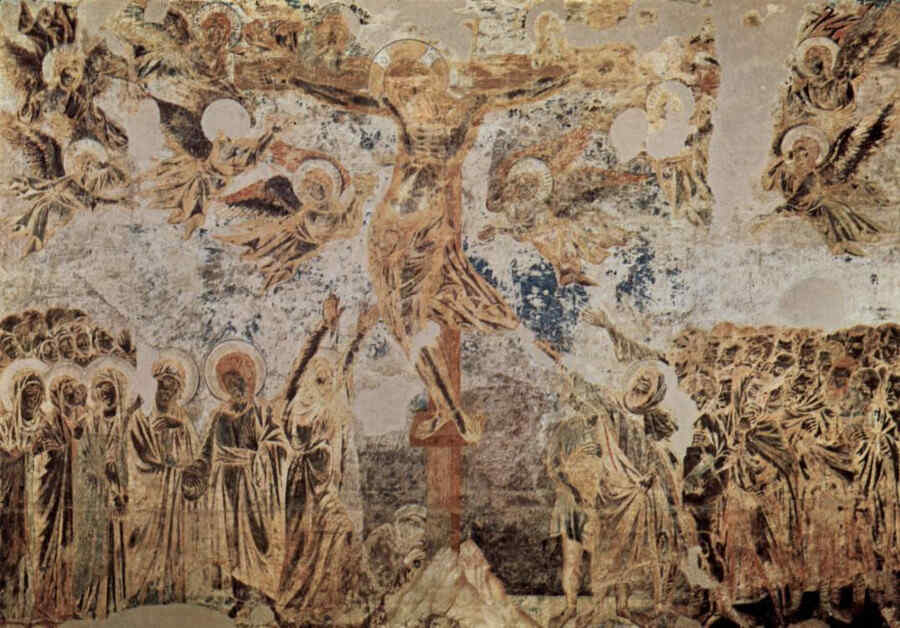
720a-7 Christ on the Cross by Cimabue.
Here with Cimabue we see something, one might say, which has been flowing into souls during all the previous centuries. You see what lives here which came over from the Orient into Hellenism. We see in the image how earth and heaven are linked, how heaven is as active in its essence as the earth too, is active. Even in the depiction of the crucified Christ we can observe the two streams weaving through one another, as I have been speaking about.
Within the world of art itself artistic creativity could not exist, while positive suggestions towards imagination was still being received out of the East.
The next image I want to show is done by Giotto:
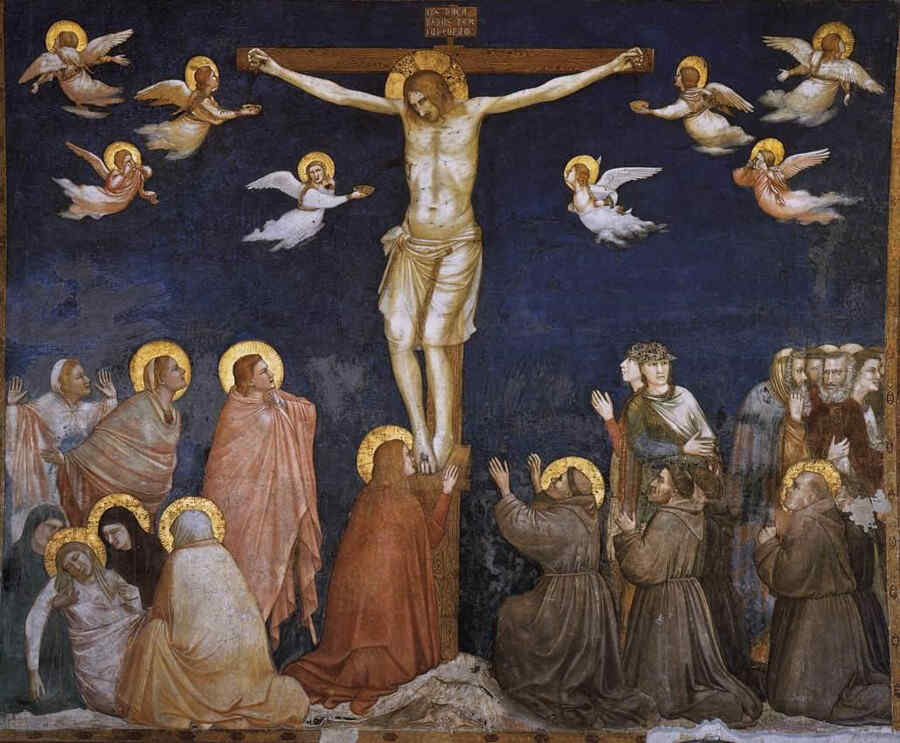
720b-36 Giotto (?) The Crucifixion, Assisi, San Francesco
You nearly see this Giotto painting developing out of the earlier one (720a-7). You can still see the heaven activated by its beings. Still, the complete descent created out of the universality of the world has not taken place and entered into the earthly world. We already see the earthly, which still quite bashfully and shamelessly throbs in the Satyr- and Faun-types, we see rising here, their control spreading, idealizing, enforcing the human being, because what wanted to be expressed here could only show itself when it was permeated by Christ, through and through.
Three things can be distinguished. Firstly those forms which exist in every cosmic soul are found in ancient art. You find then the battle of the human soul in the first depictions of Christian art. We are still in the kind of a battle as we have before us here. The cosmic element is still everywhere—I mean the spiritual cosmic, not the Copernican materialistic cosmic, but the spiritual cosmic—sparkling everywhere, yet at the same time from below the specific human soul is striving to take on the form which the soul gives to the body, wanting it to be revealed. This was the second element I want to present to you where the two battle with one another, where the human-soul opposes the cosmic-soul element. Perhaps this battle is most intensively depicted by Giotto compared to other artists. For this reason it is interesting that this particular battle can always be studied in a Giotto. Giotto strives from this one side quite significantly back to this model. He has a strong naturalistic vein yet in him remains the non-specific, one might say forms originating out of the spiritual world which were not yet so completely mastered by Cimabue. In the following image you see another “crucifixion” of Giotto:
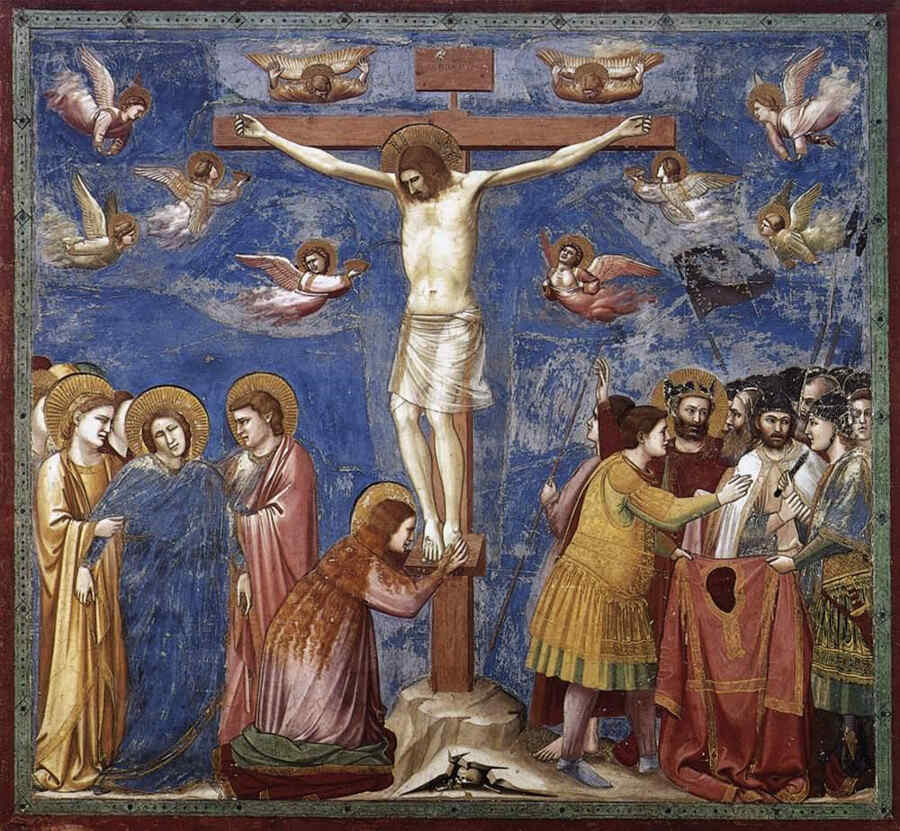
721a-35 Giotto: Crucifixion (Padua, Arena-Chapel)
The previous painting was not even a real Giotto, perhaps originating from someone else. Here we see Giotto in the most genuine sense. See how the heaven is not only implicated but definitely contributes to the image. Notice something entering here, also with the Redeemer's form—and this is our main focus today—something depicting the soul wretchedness in the way the bodies are constituted. Here we already see the human aspect coming in, which one never could see in an Apollo form.
I ask you now to not consider the fact I'm about to reveal as inappropriate. What I want to say, I say reluctantly now and I hope that you will be mistaken if you want to believe the facts are inappropriate. Research orientated at truth results in something extraordinary. When we delve into an image such as this one by Giotto, we see a new element surface in the old tradition, a Greek orientated idealization which could only appear in the Faun and Satyr, a super-imposed idealisation of the human if we look at a Giotto, and then we may essentially put Giotto as an opponent to his master, Cimabue, who was fructified from the Orient. How does something new happen to be introduced here?—Now we arrive at something which is difficult to say: it spread out from an external point, outer territories of Europe which actually had their origin in Central Europe itself, which we have often seen originating from Central Europe: the very new impulse to configure the individual human element within the soul. Very little Roman blood flow for example in the present day Italians, really very little. A great deal has flowed in—refer to historical studies as far as ancient documents allow—much has flowed into Central European blood: from this comes fructification. The naturalistic, soul principle which lived in Giotto was created by the fructification through Romanism, the unimaginative Romanism plus this emanation from Central Europe. Romanism was actually great only in ideas which pre-occupied themselves, the social structure in the sense of abstract cosmology; what one regards as “State” is really a speciality product of Romanism, originating out of the Roman soul. The state which wanted to spread out over everything is a copy of what sprung in the Roman head where it originated.
We now go to the next image, another Giotto:
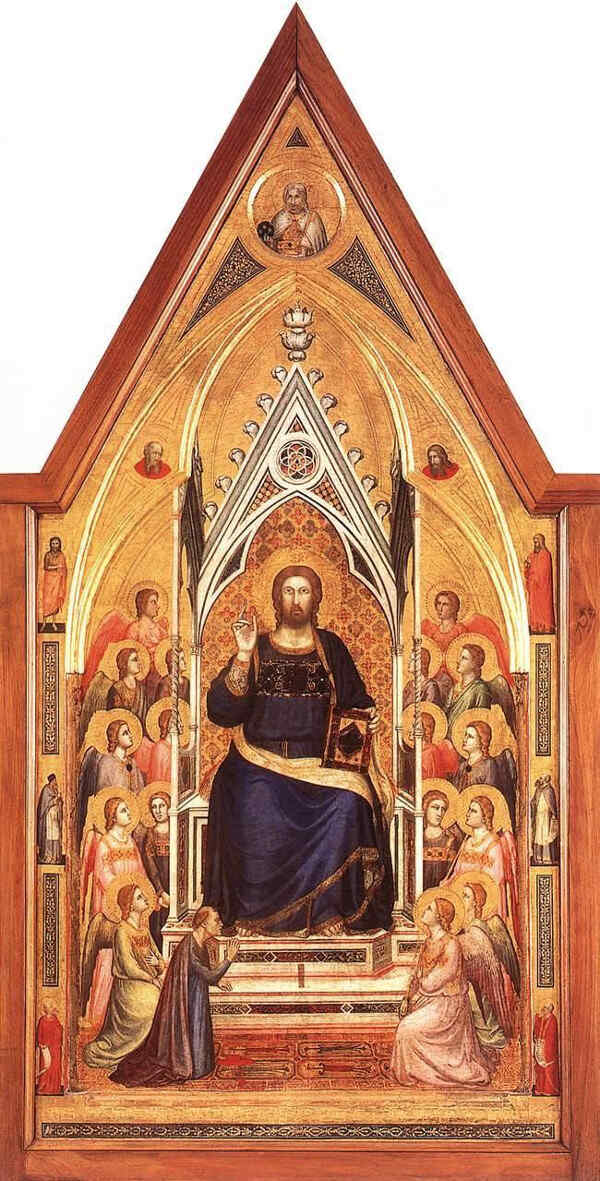
721b-32 Giotto: Christ on the throne (Rome, St Peters)
Here we see a Christ. I have chosen this image because here Giotto was most inspired to represent the old type of depiction as it came from the East. Only, look at the face, how much individuality he has brought into it! Look at each of these fingers lifted in the right hand, how many individual soul qualities have been brought into it, how in the best sense the spiritual-naturalistic lives in it! Here one gradually enters into the southern art in which the oriental essence is linked, with the cosmic-oriental essence; here enters something we have seen in images of Central Europe, something in its purity, without the cosmological essence, merely out of the human soul itself.
The next image is once again a Giotto:
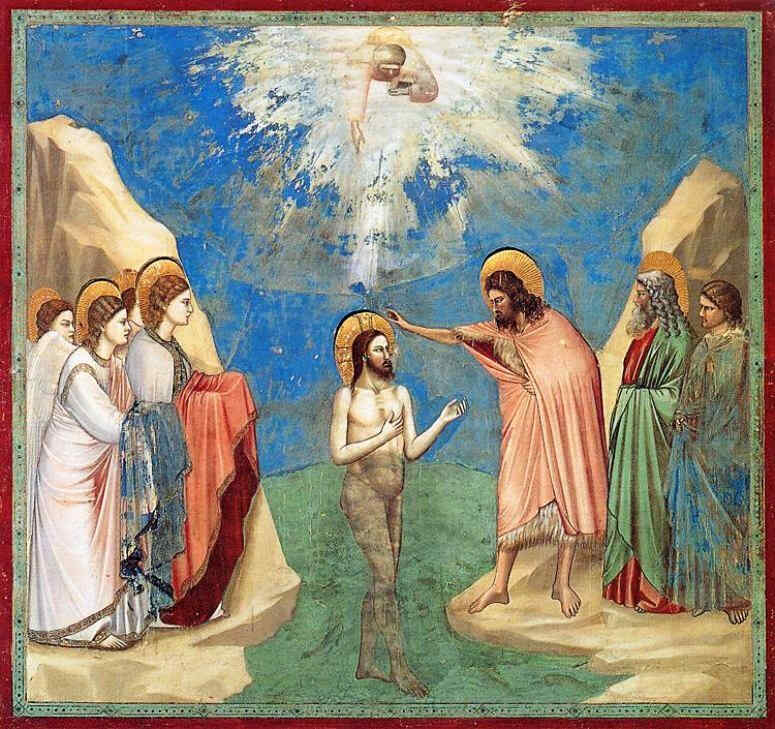
722a-21 Giotto: The Baptism of Christ. (Padua., Arena Chapel)
Here too you see heaven and earth play into it. Now just look at the Christ figure itself and you will find how Giotto made the effort to allow the soul quality of the divine form to come to expression, not only in the face but in the entire figure, in the main bearing and hand gestures.
Here we have another Giotto, the evening meal:
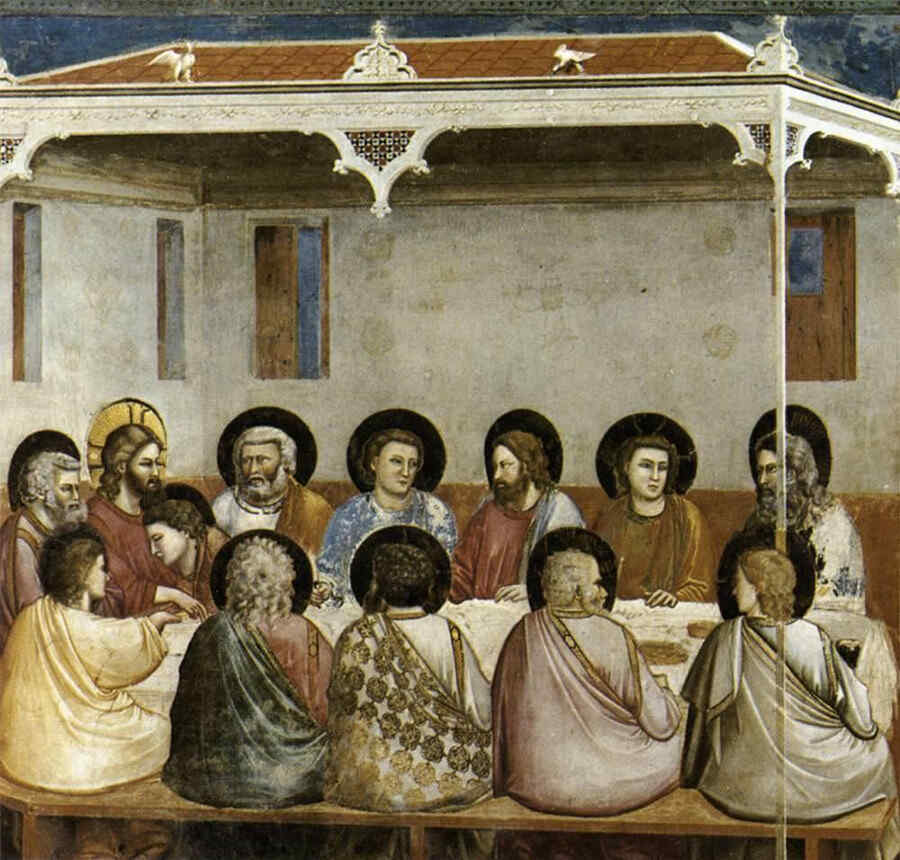
722b-34 Giotto: Evening meal (Padua, Arena Chapel)
You see Christ on the left side partly coming to expression as the Greek Christ-type yet the effort to express the individuality of soul is also being made. Everywhere this insertion is apparent and so we see this extraordinary thing streaming forth which in the highest sense is artistic, oriental and still in the old Persian cultural impulse dependant on Central Europe, one could say, having a rendezvous with the inartistic, assessed purely on a State structured unimaginative basis.
Another Giotto:
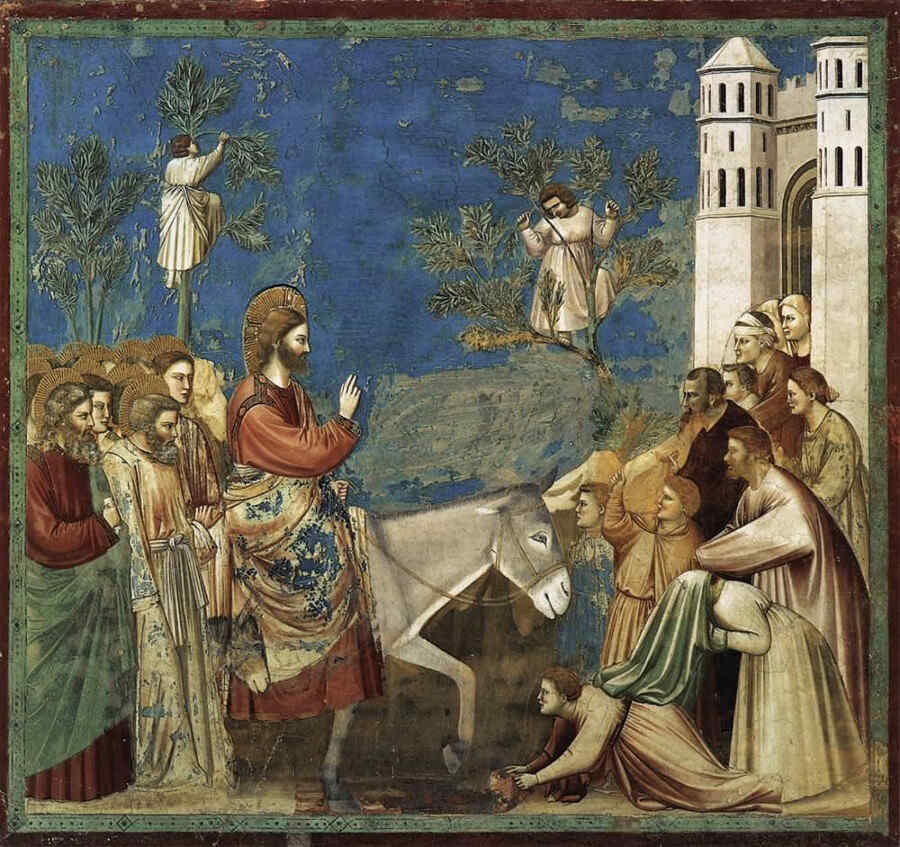
723a-40 Giotto: Journey into Jerusalem (Padua, Arena Chapel)
... which I have chosen again to present the same phenomenon to you. Just by taking these images of Christ in various biblical scenes does one see how Giotto endeavours to bring the individual expression into the soul nature.
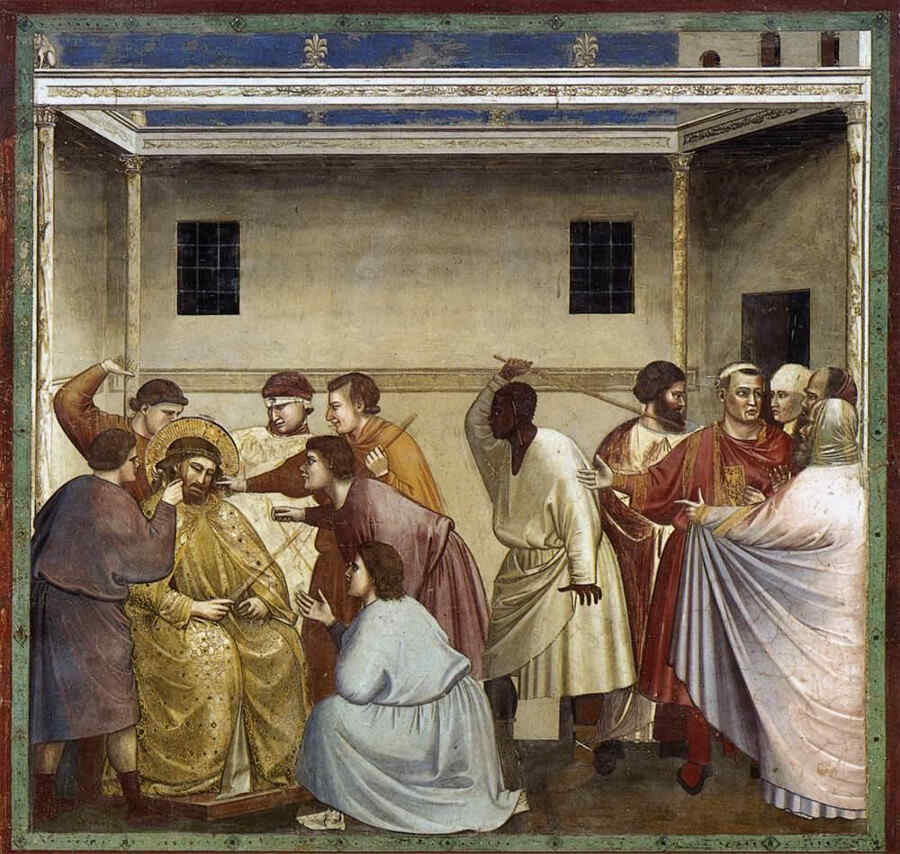
723b-33 Giotto: Crowned by Thorns (Padua, Arena chapel)
We want to bring these changes of the Christ depiction itself to you as it took place through these centuries.
Now think of the first tentative efforts we found in the ancient Christian art. Certainly a great deal depends on the material, but that materials were applied, that it was particularly used for these ideas, that is the important aspect which we see here. Now:
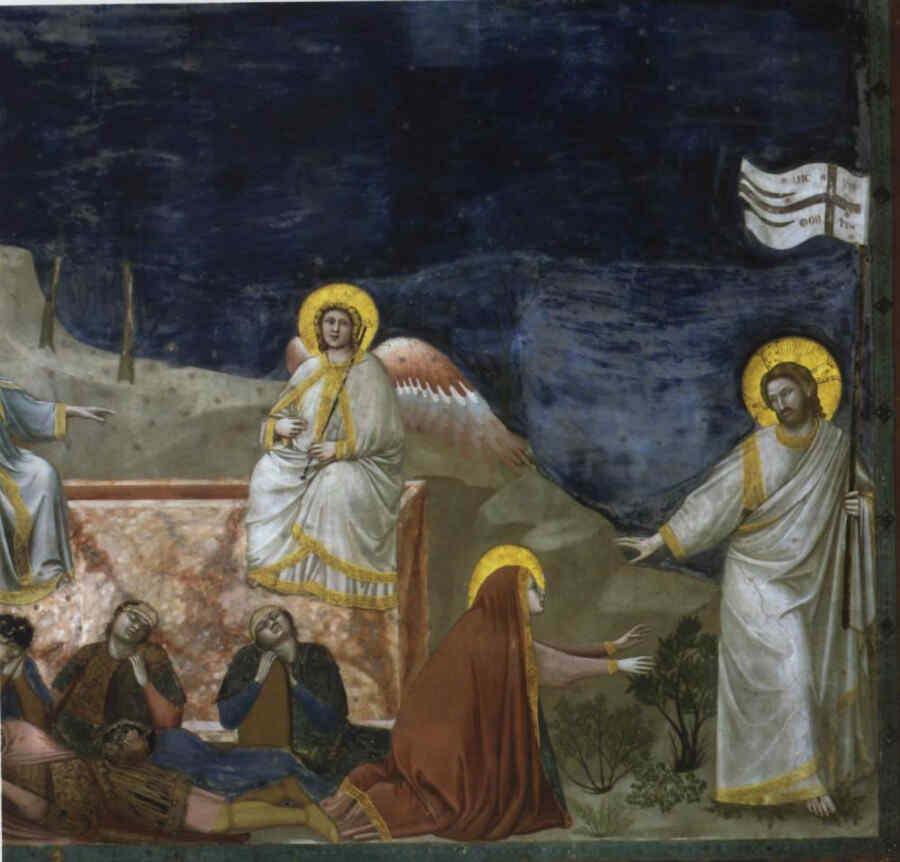
724a-31 Giotto: Resurrection (Padua, Arena Chapel)
Everywhere you'll find the confluence of both streams of which I have spoken, confirmed. Perhaps at the same time you'll notice the intensity which works further with the Greek Christ-ideal type, because in the background, one could say, in the sleeping powers of the artists it was present everywhere.
Now we come a little further. I have now chosen an image from the 14th century, by Orcagna depicting Christ as the World Ruler:
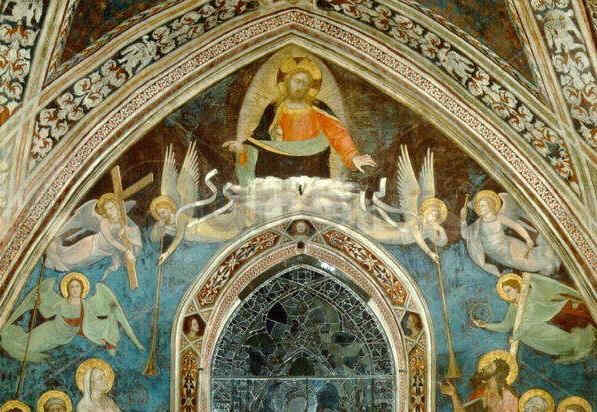
725 Andrea Orcagna: the Youngest Court (Florence, St Mary, Novella)
It comes out of the church of Saint Mary Novalla in Florence. Here you clearly see the old type as an endeavour for a complete individualisation, the soul gently appearing.
With this we are already in the 14th century. The various developmental streams of human culture move at different speeds. Up to here we don't only see the influence of the Greek Christ type but we also see some of the inspirational powers found in oriental art. I would like to state a fact and not a criticism: in all these images it does not come to be expressed what the Roman worldwide church domination within its full historical rights had initiated itself since the 9th century. The Greek influence actually existed in art with little influence from central Europe.
Understand, this had to be so, from the second half of the 9th century it went well in Rome. Everyone knew, as I expressed it once, this `Eastern Being' had to be kept back. The western world had to be permeated with it out of the basis of the life of the folk striving towards something higher. Out of this we see a sentiment which I have characterised for you, which I identified with the liberated city culture, this free city culture which has its point of origin from central Europe and spread itself over various other territories. These free city cultures had the urge to express the specifically human soul element. Now in the 9th century Rome understood and thus considered this European impetus and carried it into account.
The specific western form of Catholicism which spread through the institutionalised world churches was by contrast being held back in the Orient, and this Catholicism came to a specific expression in those artists and their art as most wonderfully expressed by Fra Angelico:
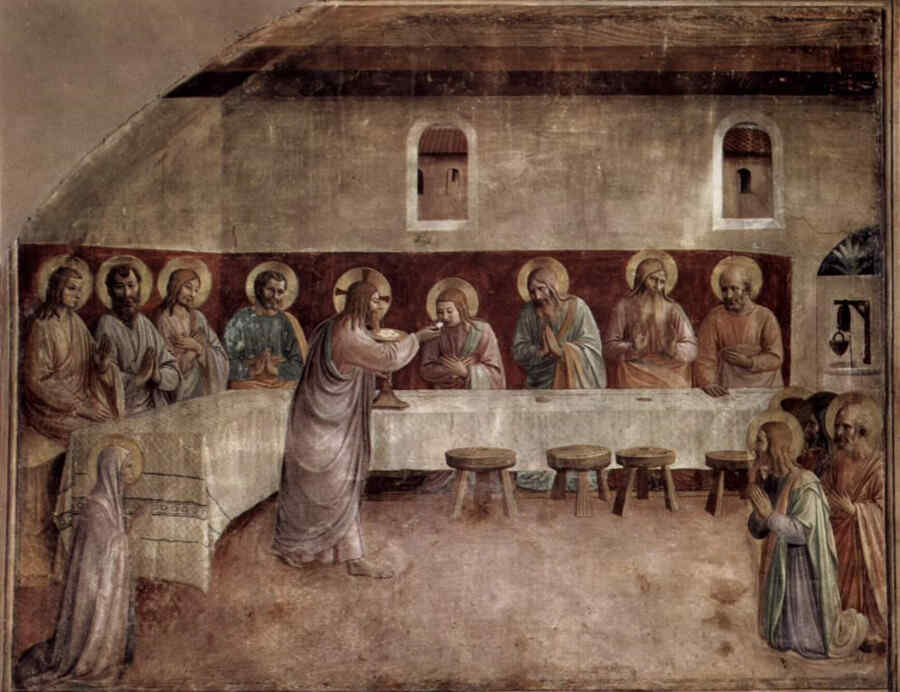
724b-65 Fra Angelico: Evening Meal.
Here firstly we see—when we have an understanding for such things—the western Catholic element poured out in art. The differences between the previous (725) and this image (274b-65) as well as the previous Evening Meal (722b-34) and this image (724b-65) are unbelievable, because in these images, as it lives in well loved art, the western catholic sentiment is alive. Look at the forms into which the sacrifice has been brought, woven equally into the composition as a reminder of the Last Supper before the event of Golgotha. You don't only see the Last Supper but you see the continuation of the evening meal within the composition of the catholic sacrifice. Catholic sentiment is poured out over the image of the evening meal and particularly over the figure of the Redeemer. Here, primarily, the Redeemer is shown as a model in art to western priests. In reality He had been there much earlier, in outer reality.
Thus we see the Roman world domination church spread its rule also over art in a totally decisive manner. In addition we can say Giotto created his artistic offering of Francis of Assisi out of a freed individual soul. Here we can see Fra Angelico who paints as well as Messe reads in San Marco in Florence. An aura of Catholicism permeates these images. He isn't an individual sacrifice, but paints the church with it.
No less you see this in the following image of
726a-64 Fra Angelico: Crucifixion
Catholicism paints into the art.
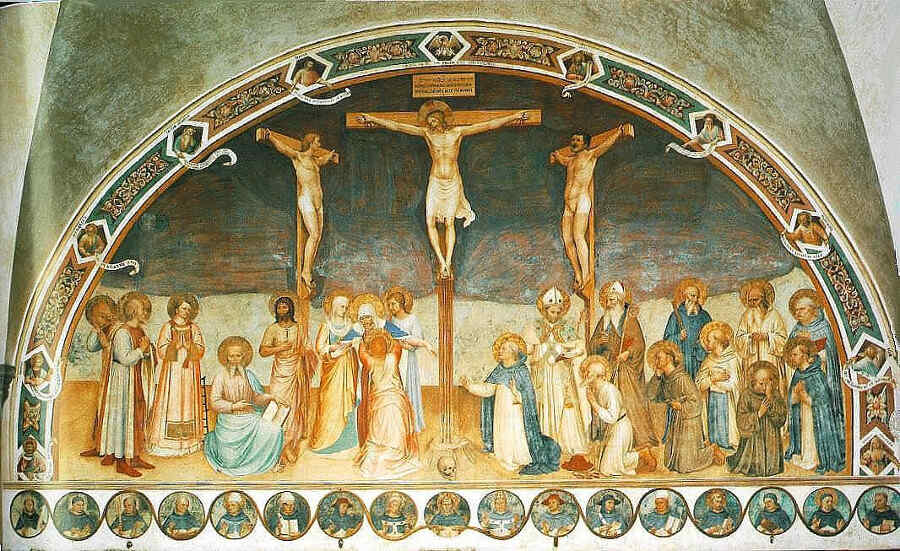
I ask you please to look closely at the next image and see how the being of the Catholic art actually is alive in the Catholic organization, that even in world domination, one could say, the organisational power of the Catholic Church works right into the realm of supernatural beings.
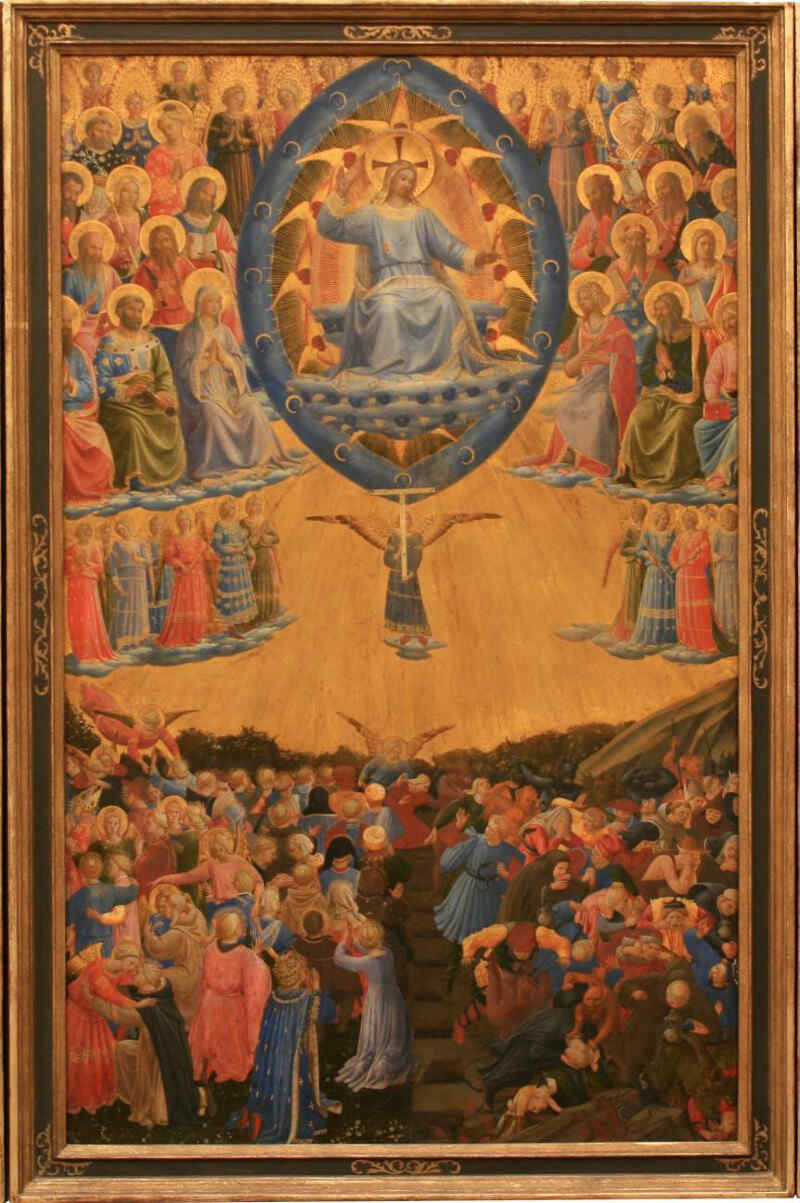
726b-68 Fra Angelico: World domination
We find this now increasing with another friar, of which I want to show you the following image:
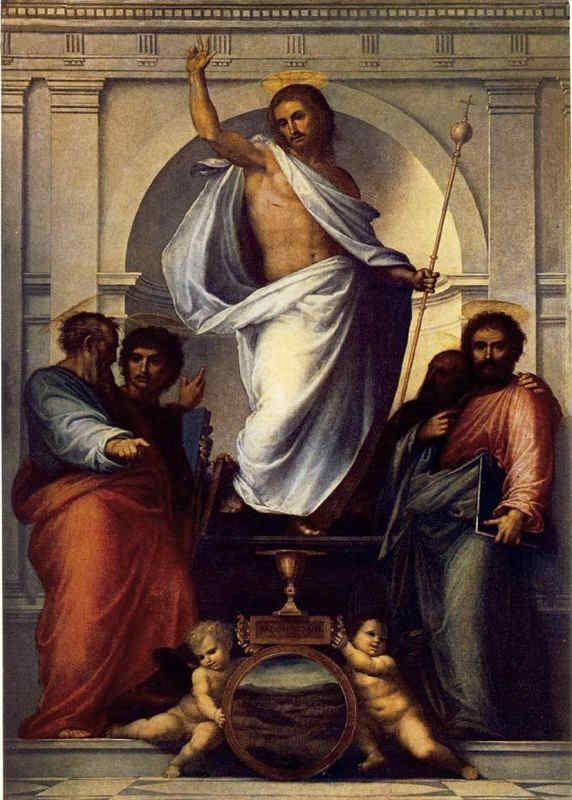
727 Friar Bartholemeo: Christ and the Four Evangelists
Here we see the third stage in this interesting process. Look at the interplay of a new freshness as a resurrection out of old Hellenism. This entered now again, the old Greek influence.
So we notice how for a long time the individualized soul concept of the Christ-type, which is of interest to us today, prevailed. Take the entire design as it evolved from the cosmic forces working from the beginning, which are then taken up as the individualised soul through the Greek impulses influencing it ever more, and how through this it became increasingly individualised. How was Christ individualised, my dear friends? Now we see how antiquity so recently intervened just a little but it is already in it. It is again working from the characteristic towards the typically-beautiful. This is notable as being continuous, because this is actually the secret of the Renaissance. These images I want to show you in conclusion are the starting point for the Renaissance artist, we see how the Renaissance artists completely renewed a rise in Hellenism but they didn't enter into that which conquered the form of an individual.
Here you have the Evening Meal of Andrea del Sarto which is in Florence.
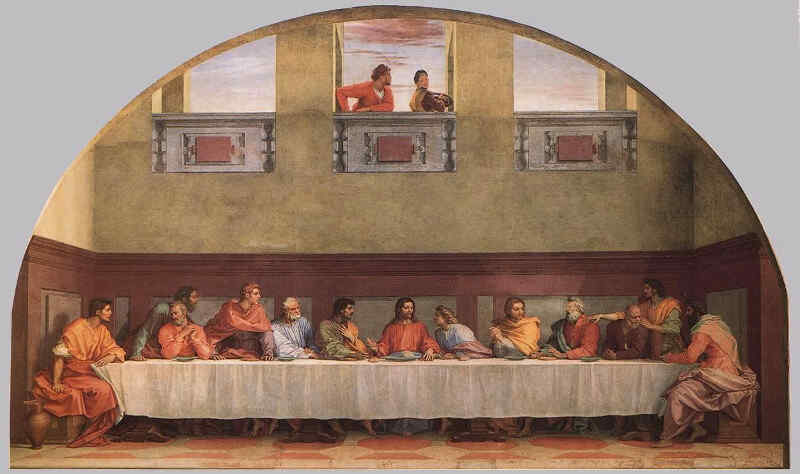
728 of Andrea del Sarto: Evening Meal.
Again there are beautiful forms, with still a touch of cosmic consciousness which the Greeks still had, something of the traditions of a cosmic element brought into the forms but purely out of tradition and no longer from direct observation, with direct feelings as found among the Greeks. We discover it here; this is brought further by Raphael, Leonardo da Vinci and Michelangelo. We see something developing here which is particular to Leonardo da Vinci, in this image of the baptism by Verrocchio, the teacher of Leonardo.
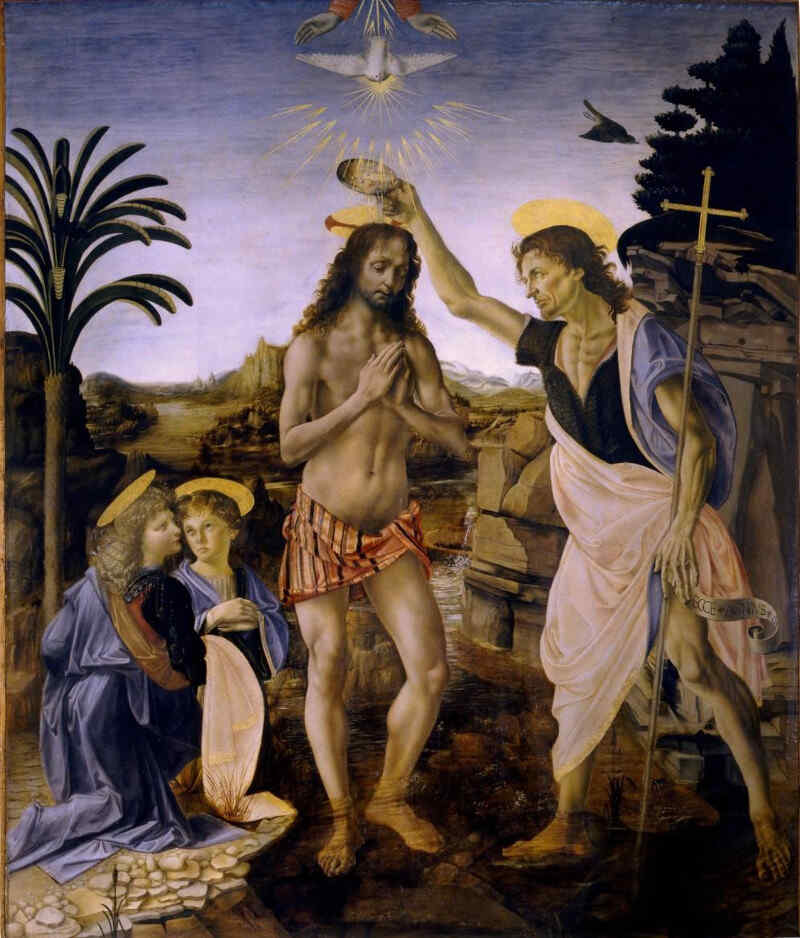
729a-92 Verrocchio: Baptism of Christ
The same motive done by Masolino during the same time period:
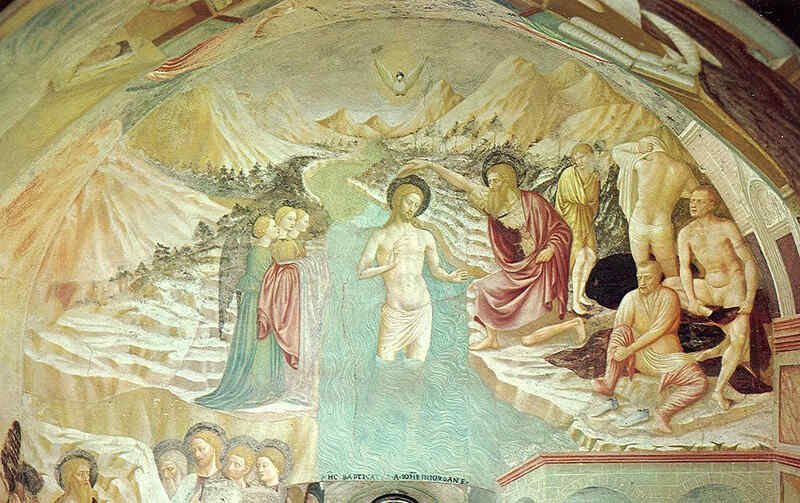
729b-50 Masolino: the Baptism of Christ
Yet again I want to include the image “The Baptism” by Giotto:
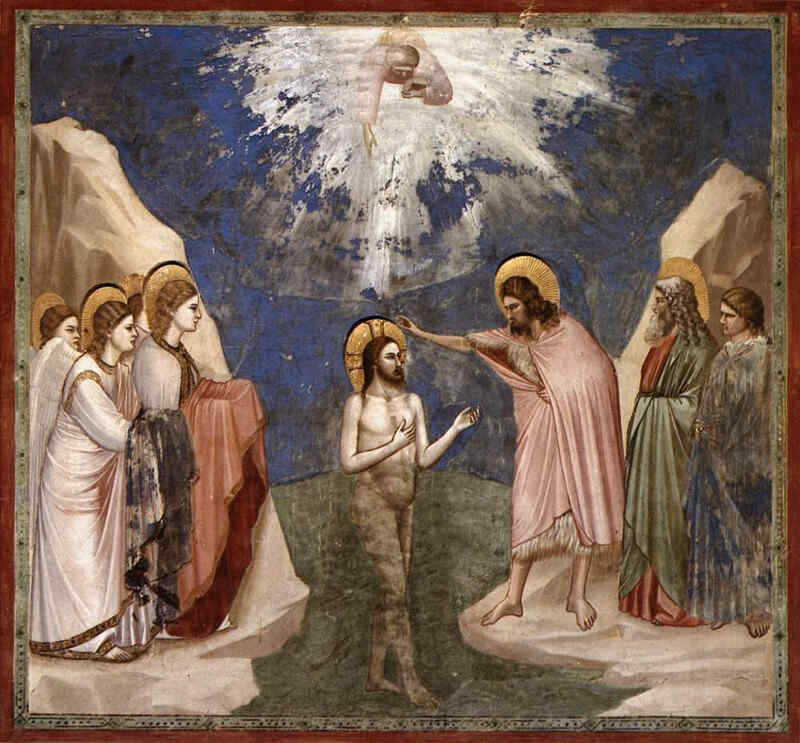
722a-21 Giotto: the Baptism of Christ
Look at the Baptism where the battle is still on between the two principles, without the Greek influence, also without the antique Greek impact, without the impact from antiquity, to the new Greek, the Christian impact particularly strong.
Now we bring out the two other images:

729a-92 Verrocchio: Baptism of Christ
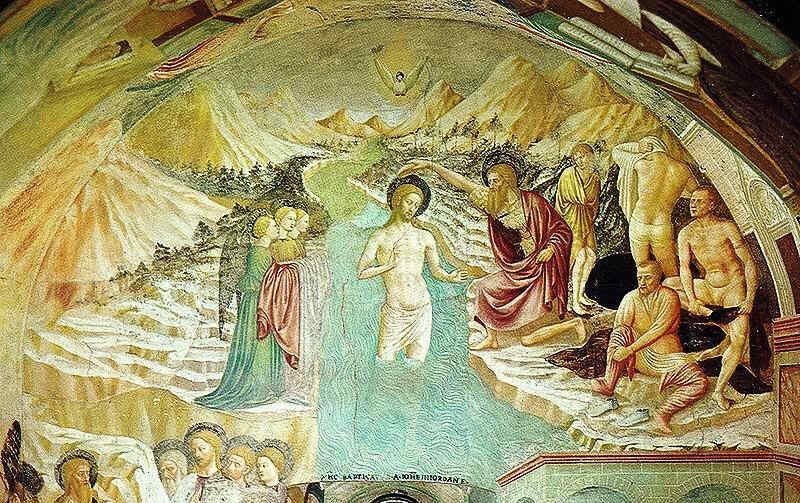
729b-50 Masolino: the Baptism of Christ
You see how the Renaissance works. Out of a Verrocchio comes a Leonardo; perhaps Leonardo even worked on these paintings too.
Now I would in closing still show 2 paintings, in which you would be able to see what came over from the North, from Central Europe and how all of this mixed into the others. We have a northern product here, the Man of Sorrows, by Dürer:
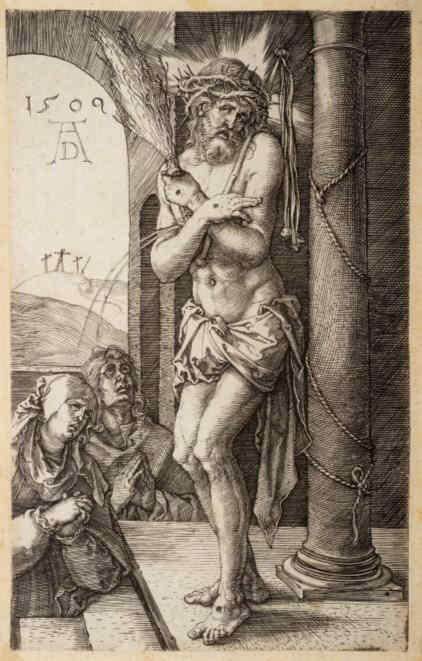
730a-303 Dürer: Man of Sorrows
Here we have the endeavour without a cosmic aspect: the human Christ. Where Fra Angelico poured the Catholic aspects over his artistic creations, here we see the formation against world domination, here we see how the human individual wants to depict His Christ. Here a single human being worked on one image. While Fra Angelico painted in the San Marco Church in Florence, the whole Catholic sentiment painted with him. Here a single person worked on his biblical depiction. This became fixed in this particular time. Later the Renaissance came but moved South, mixing with other influences.
I still have another image which depicts a similar kind of thing:
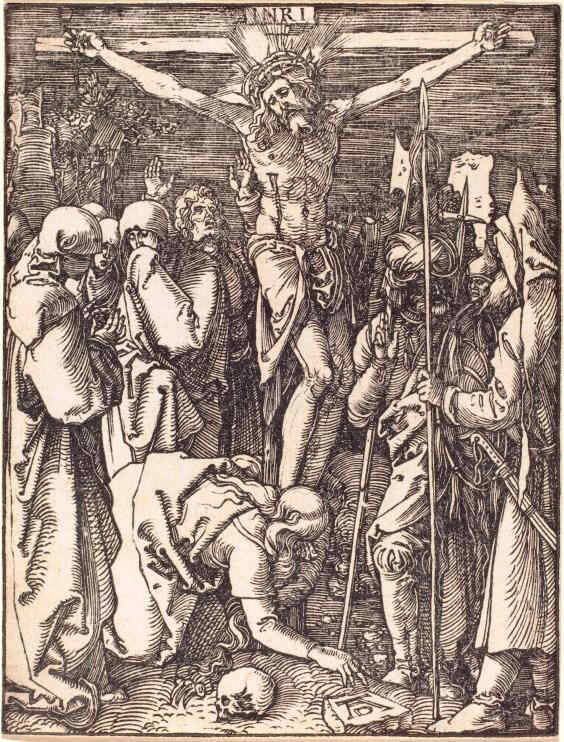
730b-311 Dürer: Christ on the Cross.
These things should show us how through the centuries the Christ image changed. I have demonstrated this with these two images from later centuries. I would like in the further progress of these ideas, if it is possible, to show you how these Christ images develop further. A world history can be written since the Mystery of Golgotha by simply describing the changes in the development of the Christ paintings and images. Everything which in reality contributed to it is expressed clearly. One could continue with this right up to the present.
Christ depictions are researched at the present time: years ago I saw a whole collection of Christ images in an exhibition, the one more hideous than the next! Today the attempt is to make reflections of present events thus reflecting the chaos leading up to events in which we live. If we try—without this tendency I've just spoken about in the creation of Christ figures—if we try to introduce what lies within this form in the spiritual world, shaped initially by our first efforts through painting, as good as it gets with limited material, then it does appear as a further progress on this cultural line of the realities of humanity's unfolding.
RUDOLF STEINER
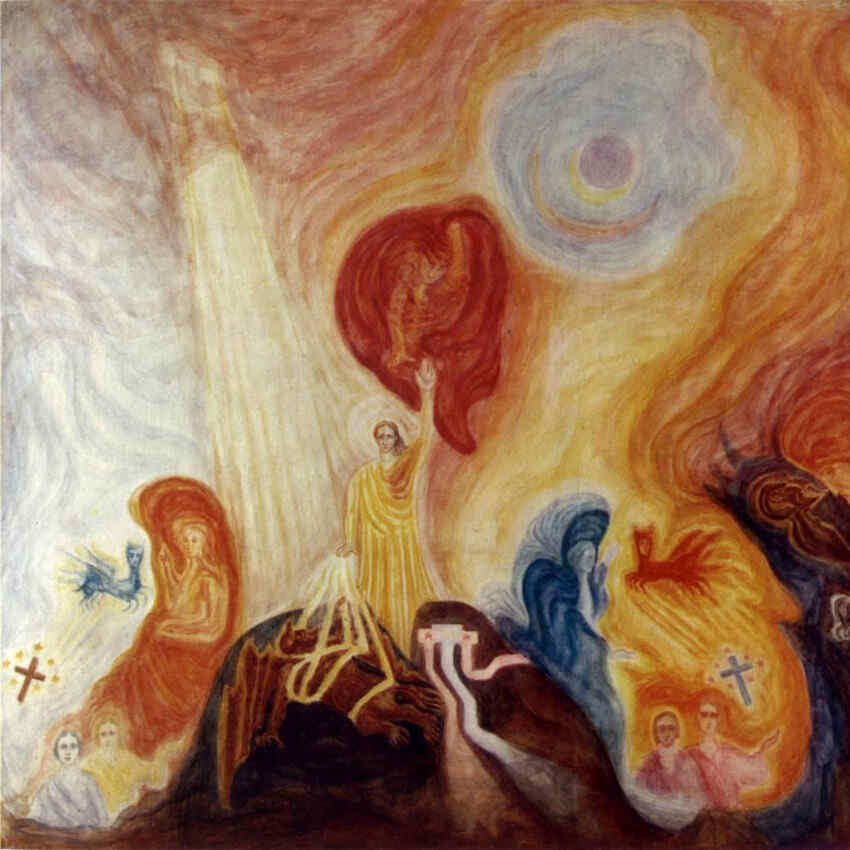
731 Painting (Plant colours) in the small cupola of the First Goetheanum, Dornach, detail with the central motif, with part of the architraves.
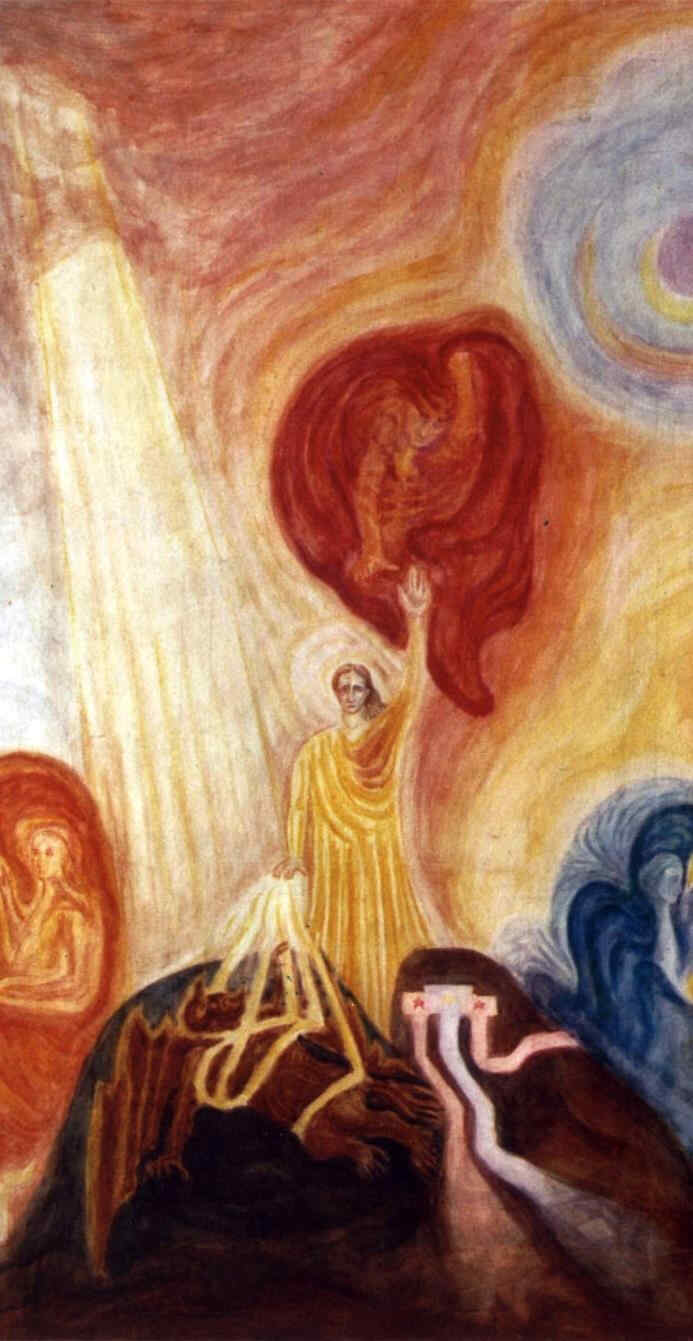
732 Painting (Plant colours) in the small cupola of the First Goetheanum, Dornach, Central Motif: The Representative of Man between Lucifer and Ahriman.
732 Painting (Plant colours) in the small cupola of the First Goetheanum, Dornach, Central Motif: The Representative of Man between Lucifer and Ahriman.
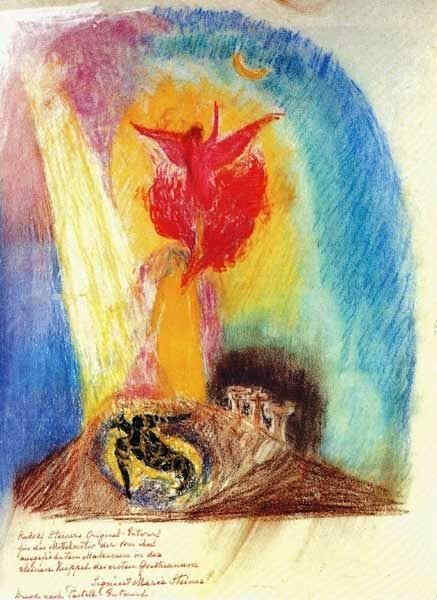
732 Painting (Plant colours) in the small cupola of the First Goetheanum, Dornach, Central Motif: The Representative of Man between Lucifer and Ahriman.
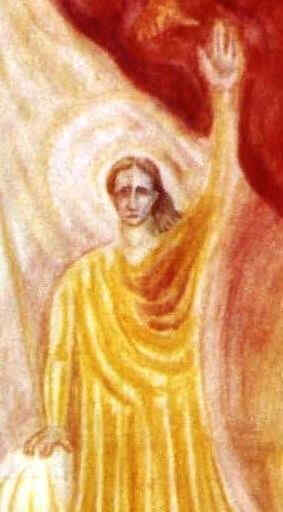
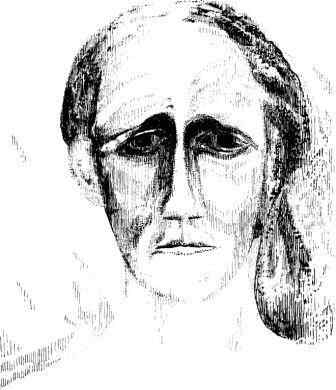
734 Painting in the small cupola of the First Goetheanum, Dornach. Section: Bust of The Representative of Man.
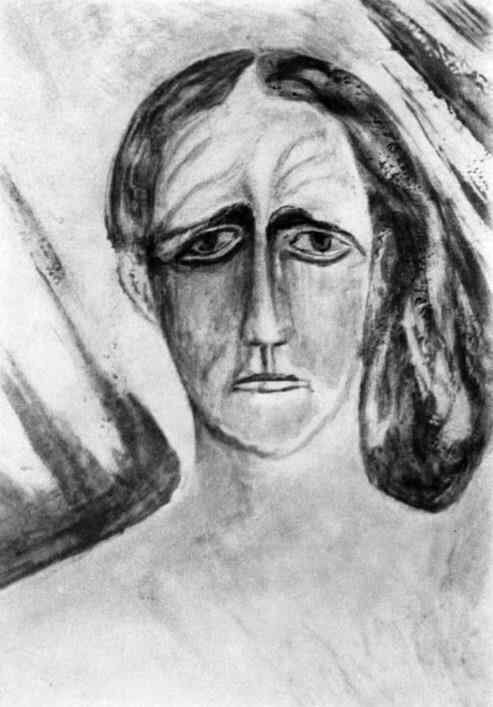
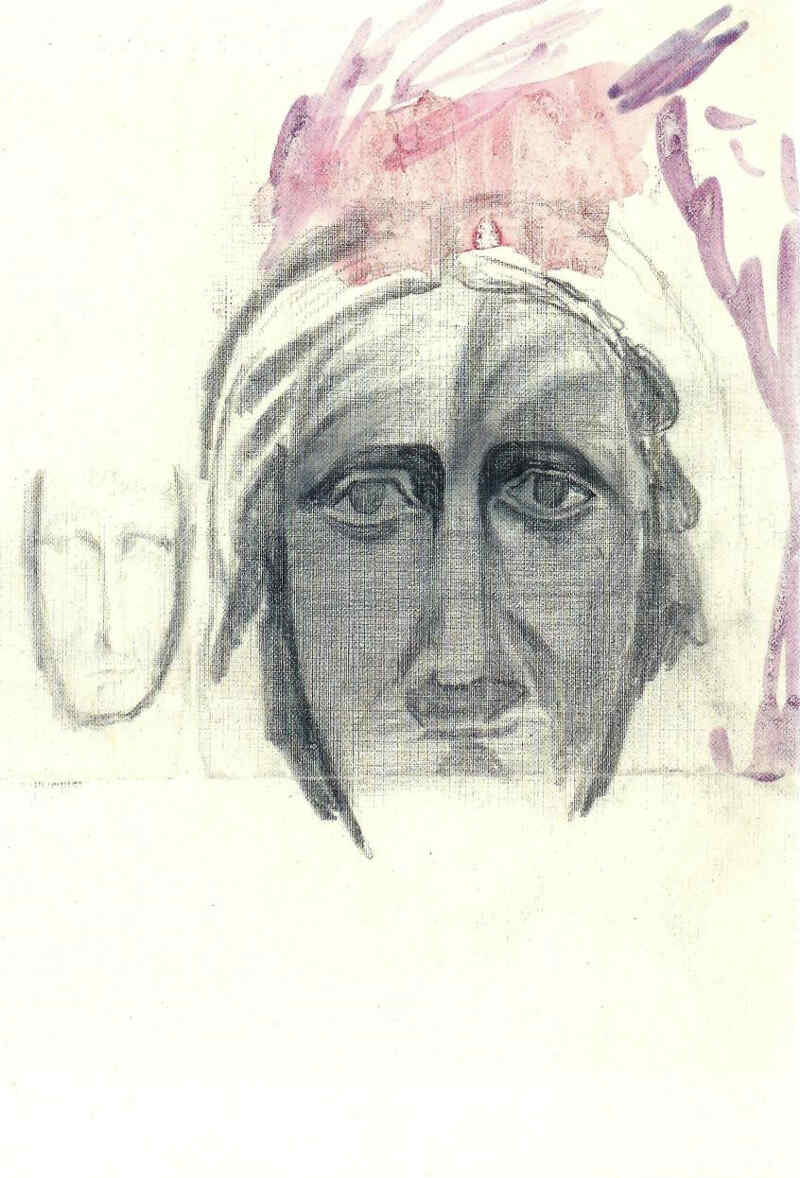
735 Visage of The Representative of Man, pencil sketch.
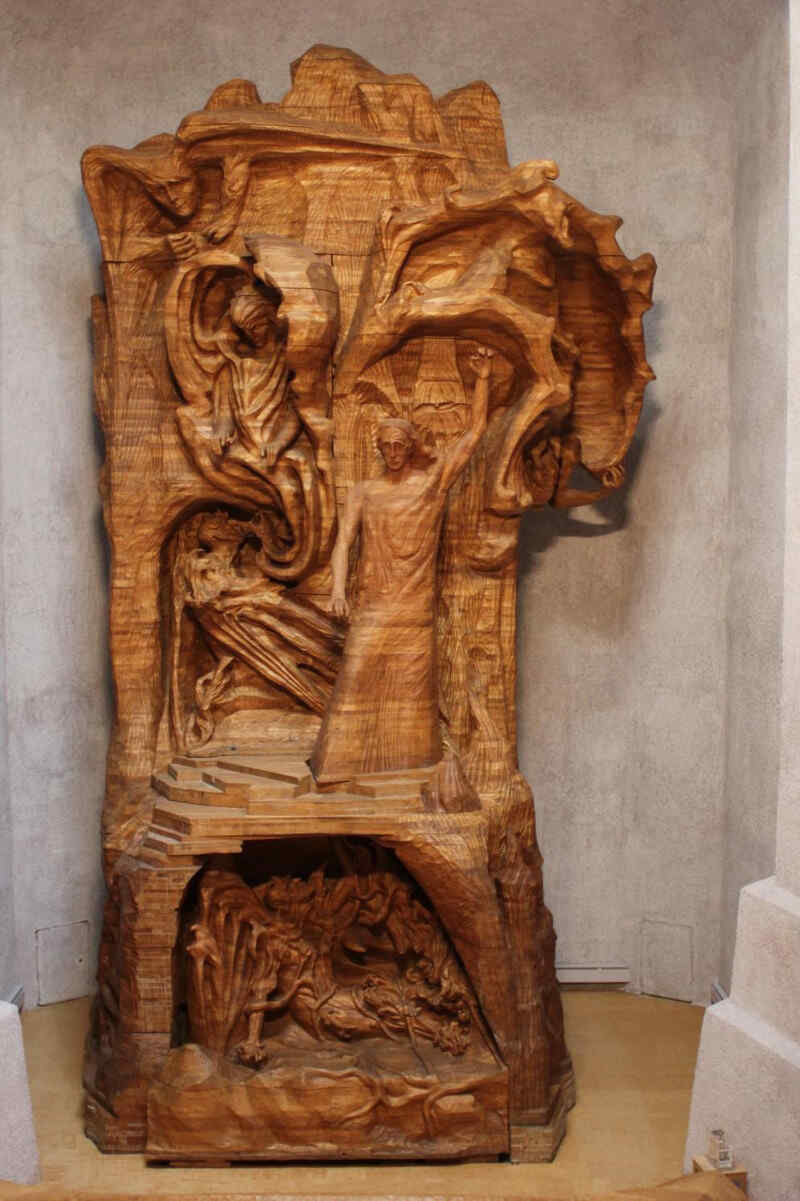
736 Wood sculptural group: The Representative of Man between Lucifer and Ahriman.
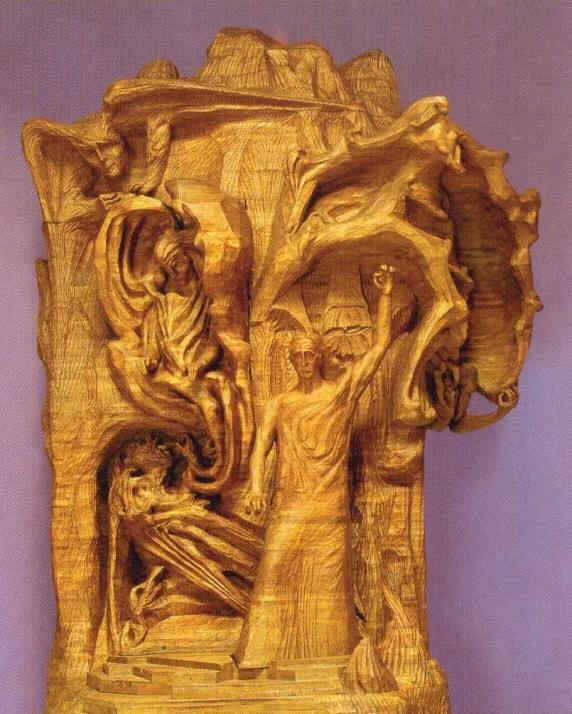
737 Wood sculptural group: Detail: The Representative of Man.
738 Maquette for the wood sculptural group, a Plaster of Paris cast.
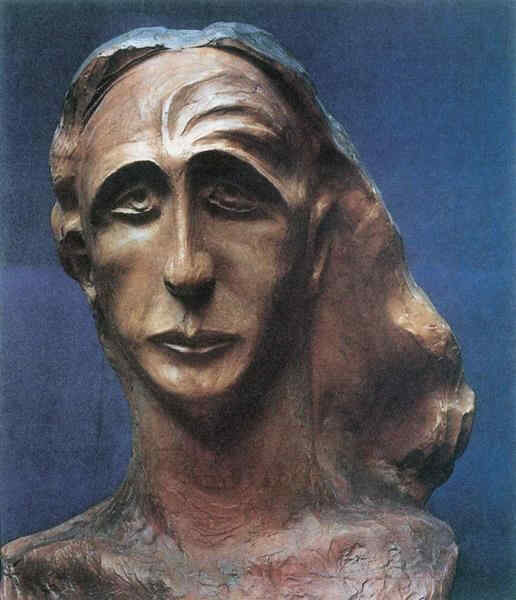
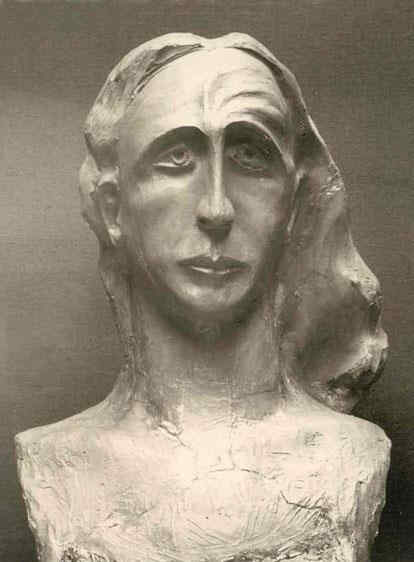
739 Wood sculptural group, detail: Head of The Representative of Man, side view.
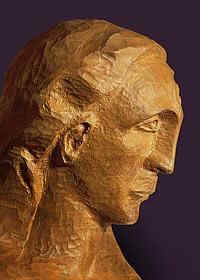
740 Wood sculptural group, detail: Head of The Representative of Man.
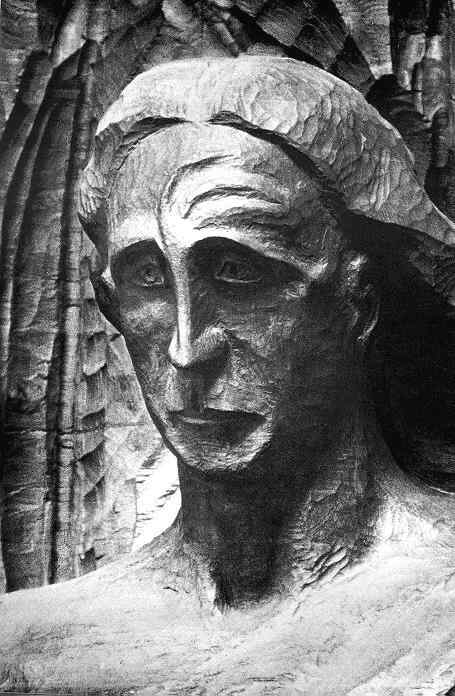
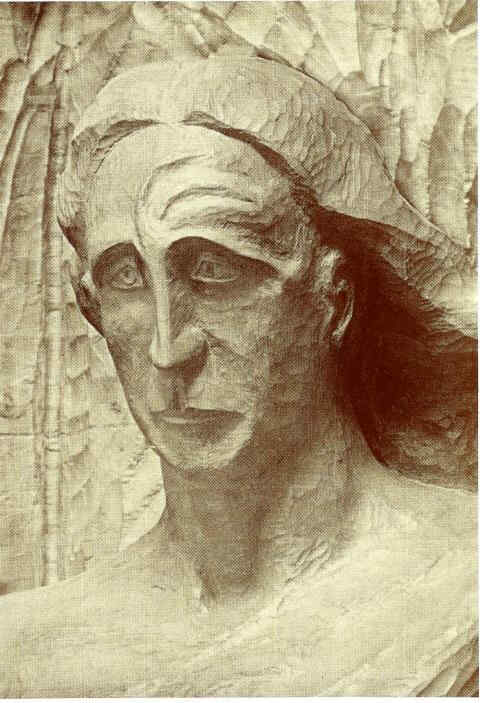
741 Study of the head of The Representative of Man, plasticine.

It is really good in the present time to fructify ourselves with such ideas which can be gained from cultural areas of art, and see a bit of the truth, because in the present time gods will be offered to mankind to be worshipped, while mankind will have no talent for seeing the truth.
In our time (1917) it is possible to say that four fifths of the world should ally itself against a fifth, in a time when so much indifference is accepted, it is time for recorded concepts to be taken out of the history of humanity's evolution and to revise them a little.

